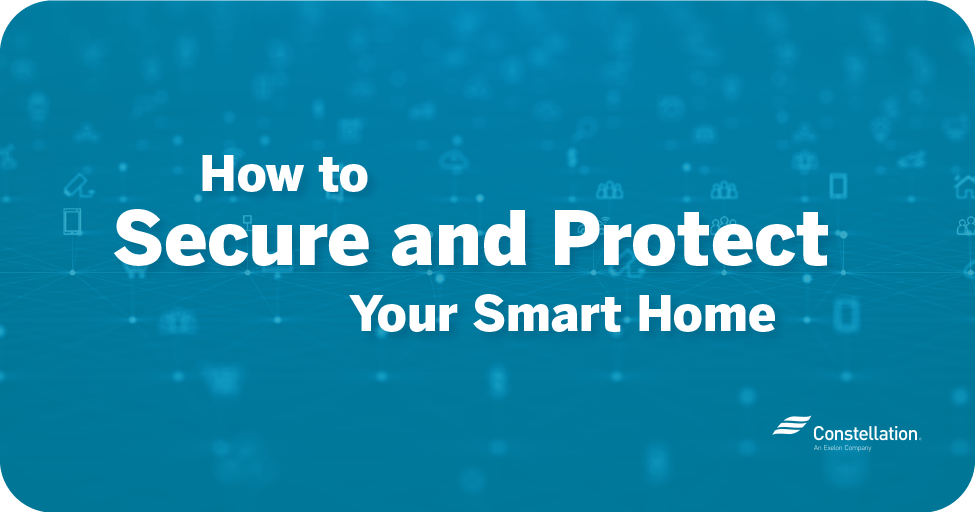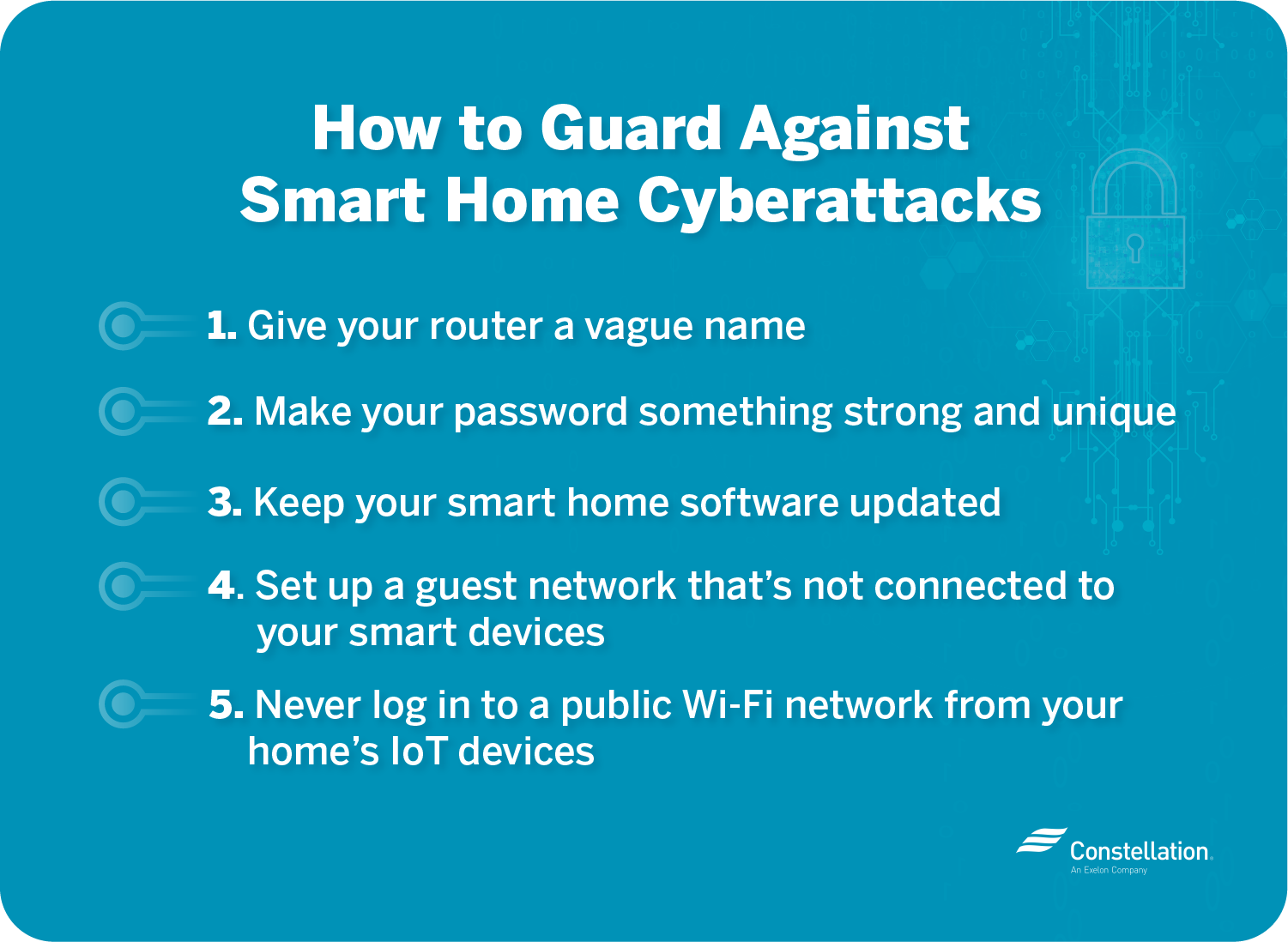
- Category:
Home Energy Savings -
Last updated:
October 22, 2020
How to Secure and Protect Your Smart Home
Home security strategies take on an added dimension when you install smart home technology. On the one hand, smart devices can greatly increase the physical security of your home. On the other, they can make your systems vulnerable to hackers — if you aren’t careful. This article covers the basics of keeping your smart home secure on both fronts with the latest home security best practices.
Is a smart security system the best way to protect your home?
One of the best home security strategies is installing a smart security system. A survey of home burglars points to a number of deterrents that smart security systems effectively deliver. You can:
- Monitor your home remotely.
- “Answer the door,” even when you’re far away. Most burglars ring the doorbell to see if you’re home before they try to break in.
- Turn interior lights on and off without a set pattern. A well-lit exterior, with lights that seem to go on and off at random, is also a deterrent.
- Program your television or radio to play throughout the day. Most thieves said they wouldn’t try to enter a home if they could hear the sounds of a TV or radio, so a smart system that turns them on and off helps.
- Make cameras visible. Because thieves don’t want to be spotted, seeing that you have a security system may scare them away.
6 Basic Home Security Best Practices
When considering how to protect your smart home, put these physical home security best practices into action:
-
Invest in a home security alarm system. Alarms are proven to be the best deterrent against burglars. When the alarm goes off, they know the police are on the way. Thieves won’t take the risk of getting caught. A home security system makes financial sense because it protects you from losses and adds to the value of your home.
Keeping your smart home secure is easy with systems like Constellation Connect. Smart home security alarm systems require little to no expensive wiring to install and give you enhanced control, even remotely.
- Utilize landscaping to create a barrier around your home. Thieves tilt the odds of getting caught in their favor by staying out of sight as much as possible. Thick bushes that shield views to your back door, windows or garage give them the cover they need to enter your home without attracting attention. High fencing that’s difficult to scale or thick, spiny bushes around the perimeter of your property could possibly keep some intruders out. But if trespassers were to make it to the other side, they’d be shielded from detection by the very same measures that were supposed to protect you.
- Call your local police department to get a home security audit. Law enforcement professionals are familiar with burglars’ methods and can spot vulnerabilities that escape your notice. Many police departments offer home security tours and audits at no cost. This is one of the home security strategies that can bring you the most benefit. Often, small changes can eliminate big risks.
-
Always lock your windows and doors. Security for smart house protection starts with the obvious — locking all entry points to your home. You would be surprised how often this most basic of home security best practices is neglected. You might consider your neighborhood safe, but thieves look for opportunity everywhere. Many home burglars gain entrance through an unlocked door or window. Others get in by kicking in a flimsy door or forcing open a sliding door.
If you have a key hidden outside, criminals often know all the likely places to look for it. Smart locks give you more robust physical protection. Moreover, you can remotely check to make sure every window and door is secure. And because you’re in control of access, you don’t have to worry about locking yourself out, either.
-
Keep valuables out of sight. Don’t advertise your home as being a rich target. Leaving expensive things out where they can be seen attracts the attention of thieves. If you have a smart home system, you can tilt your blinds to let in light but block anyone trying to peer in from the outside. Place electronics in closable cabinets. Lock valuables in a safe. For bulky valuables, you might consider creating a strong closet with a reinforced door and walls and a smart lock.
Security isn’t just physical, though. Be careful what you post on social media. Images from inside your home or your vacation pictures that you post online may be an irresistible invitation to criminals.
-
Keep your home looking occupied when you’re on vacation. Most thieves plan their targets in advance. They want to figure out your habits and determine when you’re likely to be away from home. Leaving the kitchen light on or attaching it to a timer that creates a simple pattern is easy for burglars to spot.
However, with smart home automation security, you can use an app to set up a series of routines that open and close your blinds. One of the best smart plug uses is to set random patterns for turning on and off lights in different rooms at different times. Ask your neighbor to park a car in your driveway and look out for mail that might clutter your front step. You can also use apps and a speaker to appear to answer a door when someone rings the bell.
How to Guard Against Smart Home Cyberattacks
While many home security tips and tricks refer to the physical security of your property, if you have a connected home, you should also take the time to learn how to secure smart home technology. Protecting smart home devices from getting hacked is as important as preventing your back door from being kicked in. Here are some basic tips for how to protect your smart home systems.

1. Give your router a vague name
Protecting smart home devices starts with your router. Too many people give it a descriptive name, like the name of your family or even your address. Name it something incomprehensible and deprive criminals of valuable information.
2. Make your password something strong and unique to protect your smart home
Internet of Things (IoT) products are devices that connect to your smart home systems. Many of them come pre-loaded with factory-set passwords — passwords well known to hackers. It’s absolutely vital that you change usernames and passwords when you install devices as a first line of defense in preventing smart home cyberattacks.
How to make the best password for your IoT devices
Good passwords avoid obvious options like family names, birthdates, the names of pets or your street name. Random character strings without any meaning are your best option. Good passwords include the following:
- Uppercase and lowercase letters
- Numbers
- Special symbols (*#$~)
- Random character placement, like “Z6$hs(dR” instead of “Camera12!”
3. Keep your smart home software updated
Another key to how to protect your smart home is to download software updates to your devices as soon as they’re issued. Software updates often include security enhancements that are important for protecting smart home devices. If you fail to install updates, you leave your systems vulnerable. Smart home upgrades enhance the value of your property while smart home system updates keep everything secure.
4. Set up a guest network that’s not connected to your smart devices
When you have guests, they’ll likely want access to your Wi-Fi. Opening your smart home network to outsiders is risky. It’s unlikely your visitors are hackers, but their devices could have viruses that can migrate into your smart home systems. Setting up a second, separate Wi-Fi access point for guests is a good way of keeping your smart home secure.
5. Never log in to a public Wi-Fi network from your home’s IoT devices
Staying off public Wi-Fi networks is an important aspect of how to secure smart home devices. It’s incredibly easy for any device you use to get a virus from a public Wi-Fi network. This is as true for your cellphone as it is for your IoT devices. Chief among home security best practices is to always use locked-down, password-protected internet access points or a VPN.
Home security strategies today cover more than just physical safety. You need to be as concerned about preventing smart home cyberattacks as you are about thwarting burglars. Smart home technology of the future is being designed with cybersecurity in mind, yet you should always stay proactive and vigilant. When you use a little extra caution and employ these best practices, you’ll feel much more confident knowing how to protect your smart home.




